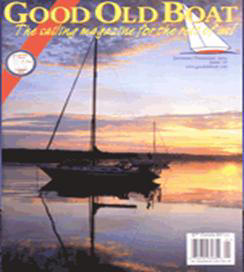|
 “One more round on the drag device
issue” “One more round on the drag device
issue”
By Zack Smith
appearing in the July/August 2002 issue of Good Old Boat.
Recently I completed a series of open-sea tests of drag devices that I
designed for U.S. military use. These tests took place under different
sea and weather conditions, including storms. When I was done I headed
back into port and took some time to catch up on my reading. I started
with the May issue of Good Old Boat. What caught my eye was a letter
written by Lin and Larry Pardey called “No Silver Bullets.” It was a
response to an article written by Cary Deringer that appeared in the
January issue. As I read it, I found myself disagreeing with the Pardeys’
blanket generalization of all drag device companies.
In their letter, the Pardeys’ claim para-anchor and drogue manufacturers
“capitalize on our fears” by using scare tactics to sell their products.
They go on to emphasize that”…brochures, manuals and sometimes
elaborate-looking books created by the gear salespeople” reinforce their
claims.
Additionally, the Pardeys attack drag device manufacturers and
distributors for having little to no seamanship experience. While I’ll
agree that most manufacturers of drag devices have limited experience on
the water, Fiorentino isn’t one of them. To date, Fiorentino Para Anchor
is the only drag device manufacturer made up of commercial fishermen and
experienced sailors who regularly test para-anchors and drogues in real
storms with power and sailboats of all sizes.
The Pardeys contend that incapable vendors regularly recommend oversized
products for profit and are”…unaware of the excessive strains this
oversize gear can exert on the boat.” Larry Pardey and I have discussed
this topic face to face. We agree that it doesn’t take a very large para-anchor
to steady a vessel in a storm. It’s how a sailor rigs the para-anchor
that heavily influences what size anchor is needed.
In most cases, monohull sailboats that heave to can use a smaller para-anchor.
That’s because the boat’s hull creates more resistance when it drags
through the water laterally. The bigger and heavier the vessel, the
easier it is to use a relatively smaller para-anchor either in a heave
to position or straight off the bow.
Big boats tend to catch more wind, which keeps tension in the para-anchor
system. Heavy boats don’t swing back and forth at the anchor like small
vessels. A smaller sailboat using a para-anchor off the bow to keep its
head into the sea should consider a stern riding sail to keep tension in
the system. The riding sail essentially catches wind, so that boat sails
backward at a fast enough pace to keep continuous drag from the anchor.
Excessive strains on a boat are a direct result of the para-anchor
system being allowed to go slack and then tighten up. A deflated
parachute or too much rode paid out are typical culprits in this
scenario. Slack in a para-anchor system means the drag device is not
holding your vessel in place and that you are momentarily drifting as
though lying ahull. The energy created as the para-anchor grabs hold of
the water whips the bow of a boat head to sea. This action places heavy
strains on the drag device and your boat.
Some vendors recommend oversized anchors because the additional drag
from the anchors removes slack in the system. Research vessels and
fishing boats may wish to use larger anchors because they typically use
the products in lighter wind conditions. Unfortunately, oversized
anchors when used in heavy weather can place additional strains on
cleats, chocks or fairleads.
With appropriate gear and instruction, drag devices are easy to work
with. In her article, Cary Deringer took the time to research all
available sources on drag devices and learned how to deploy and retrieve
several different systems under my personal guidance. As I told her,
research and practice takes the mystery out of any storm tactic.
My best advice for boaters who are considering the purchase of a drag
device is to gather as much information possible from leading U.S.
manufacturers and to take plenty of time to make their decision.
Additionally, boaters should develop a list of questions when
researching equipment for their boat and situation. For example, what is
included with a purchase? What other costs are involved? And how does
one rig a para-anchor to a particular boat? Ask about the company’s
history. For example, did the company have any product recalls? Once
boaters have these answers, they can make an informed decision and avoid
costly mistakes.
For common questions and answers about parachute sea anchors visit
Zack's FAQ's

Click
here to learn more about
Good
Old Boat Magazine.
|